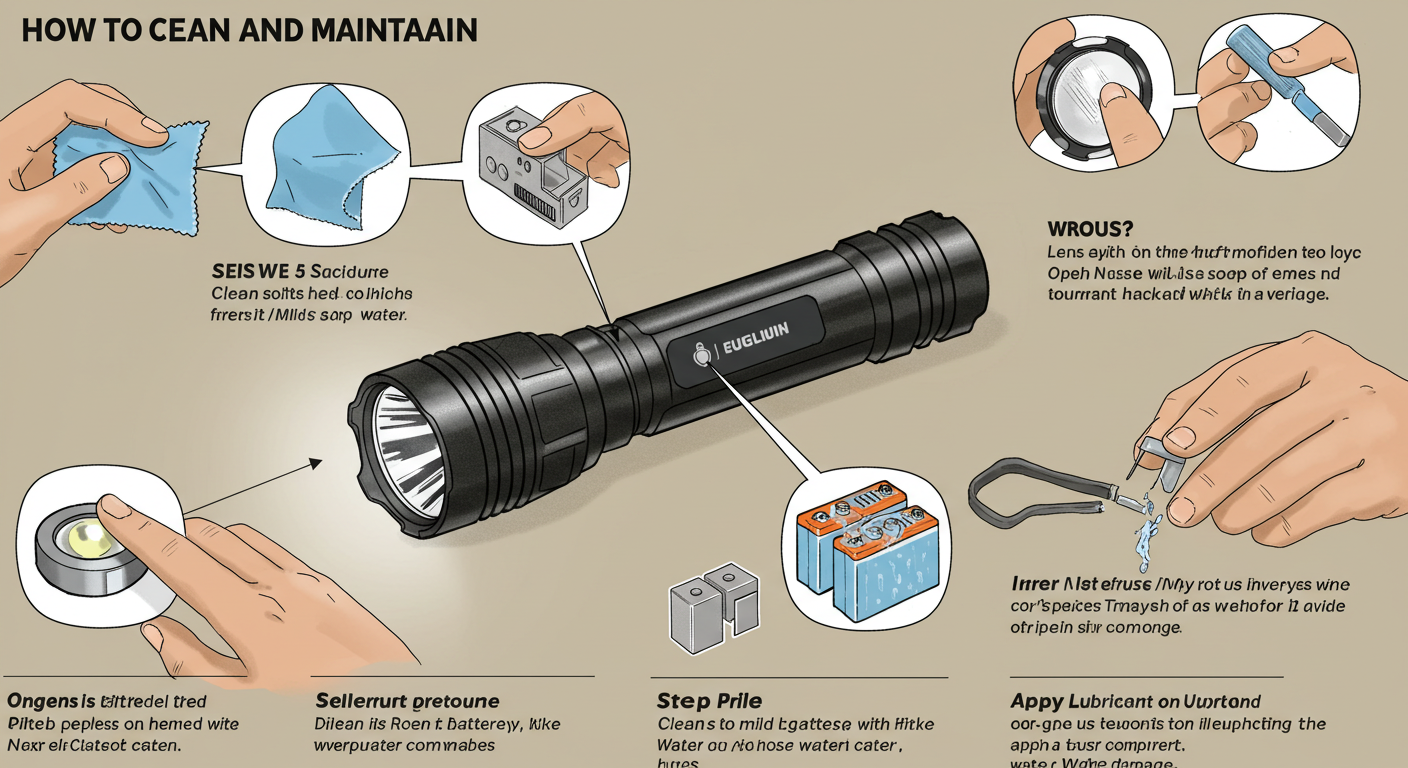How to Clean and Maintain Your Flashlight Lens

A clean flashlight lens ensures optimal light output and beam clarity. Dirt and smudges reduce brightness and distort the beam. Regular care prevents scratches and extends the flashlight’s lifespan. Follow these steps to maintain peak performance: clean the lens, remove dust and fingerprints, and inspect the battery compartment to avoid corrosion.
Key Takeaways
Clean your flashlight lens every six months to keep it bright.
Use a soft cloth and mild cleaners like dish soap or rubbing alcohol.
Keep your flashlight in a cool, dry spot. Use lens covers to stop scratches and dirt.
Understanding Your Flashlight Lens
Anatomy and Function of a Flashlight Lens
The flashlight lens plays a crucial role in directing and focusing light. It sits at the front of the flashlight, covering the bulb or LED. Its primary function is to shape the beam, ensuring it reaches the desired area with clarity and precision. Without a clean and intact lens, the light output becomes scattered or dim, reducing the flashlight's effectiveness. You can think of the lens as the "eye" of your flashlight, responsible for delivering a clear and focused view.
Materials Commonly Used in Flashlight Lenses
Flashlight lenses are made from various materials, each offering unique benefits. Here's a breakdown of the most common options:
Material | Durability Characteristics | Impact on Durability |
|---|---|---|
Borosilicate Glass | Exceptional thermal resistance, low coefficient of thermal expansion | Withstands rapid temperature changes without cracking or breaking |
Sapphire Glass | Highly durable, scratch-resistant, exceptional hardness | Provides excellent protection against scratches, ensuring long-lasting clarity |
Toughened Glass | Strengthened through heat treatment, resistant to impacts and thermal stress | Better protected against accidental drops or impacts, reducing lens breakage risk |
Mineral Glass | Good optical properties, scratch-resistant, not as impact-resistant as toughened glass | Provides a balance between performance and affordability, ensuring lens longevity |
Plastic lenses are also common, especially in budget-friendly flashlights. While lightweight and affordable, plastic scratches more easily than glass. When cleaning, avoid abrasive materials to prevent damage.
Effects of Dirt and Damage on Lens Performance
Dirt and scratches significantly impact the performance of your flashlight lens. Dust particles scatter light, reducing brightness and clarity. Smudges create streaks that distort the beam, making it less effective. Scratches, especially on coated lenses, permanently alter the light path, leading to uneven illumination. For plastic lenses, scratches occur more easily, so handle them with care. Always inspect your lens before cleaning to identify any damage or debris. A clean and well-maintained lens ensures your flashlight performs at its best.
Tools and Materials for Cleaning a Flashlight Lens

Essential Cleaning Tools
To clean your flashlight lens effectively, you need the right tools. A microfiber cloth is essential. It’s soft, non-abrasive, and perfect for lifting dirt without scratching the surface. For hard-to-reach areas, cotton swabs work wonders. A lens pen, designed specifically for optics, combines a brush and cleaning compound for precise cleaning. If you encounter stubborn grime, a pencil eraser can help remove it gently. Isopropyl alcohol is another useful tool for dissolving dirt, but use it sparingly. For added protection during storage, blue painter's tape can cover the lens and prevent buildup.
Recommended Cleaning Solutions
Choosing the right cleaning solution ensures your flashlight lens stays in top condition. A mixture of distilled water and a few drops of mild dish soap works well for general cleaning. Isopropyl alcohol is excellent for removing smudges and grime. For streak-free results, use a lens cleaning solution designed for optics. In some cases, breathing on the lens and wiping it with a microfiber cloth can suffice. Always prioritize gentle solutions to avoid damaging the lens.
Items to Avoid When Cleaning
Avoid using abrasive materials or harsh chemicals on your flashlight lens. These can scratch the surface or damage any special coatings. Stay away from paper towels, as they leave lint and may cause micro-scratches. Strong cleaning agents, like ammonia-based products, can degrade the lens material. Stick to gentle cleaning solutions and tools to maintain the lens's clarity and performance.
How to Clean Your Flashlight Lens
Inspecting the Lens for Dirt and Scratches
Before you begin cleaning, inspect your flashlight lens carefully. This step helps you identify dirt, smudges, or scratches that may affect its performance. Follow these steps to ensure a thorough inspection:
Hold the flashlight under good lighting to spot any visible dirt or smudges.
Look for scratches or deep blemishes that might require special care.
Check for any loose debris that could scratch the lens during cleaning.
Taking the time to inspect the lens ensures you choose the right cleaning techniques and avoid causing further damage.
Removing Loose Debris with a Soft Brush or Cloth
Removing loose debris is a crucial step before applying any cleaning solution. Use one of the following methods to clean the surface gently:
Wipe the lens with a dry microfiber cloth. This tool is soft and non-abrasive, making it ideal for lifting dirt without scratching.
For hard-to-reach areas, use a soft brush to dislodge particles.
Avoid pressing too hard, as this could push debris into the lens or cause scratches.
Applying Cleaning Solution and Wiping the Lens
Once the loose debris is gone, apply a cleaning solution to clean the lens thoroughly. Lightly dampen a corner of your microfiber cloth with isopropyl alcohol or a mild dish soap solution. Avoid soaking the cloth, as excess moisture can seep into the flashlight housing. Gently wipe the lens in a circular motion, applying light pressure. For stubborn grime, use a pencil eraser to rub the affected area, then follow up with the damp cloth. These cleaning techniques ensure the lens stays clear and free of streaks.
Drying and Polishing for a Streak-Free Finish
After cleaning, dry and polish the lens to restore its clarity. Use a clean, dry microfiber cloth to remove any remaining moisture. Buff the surface in small, circular motions to achieve a streak-free finish. This step not only enhances the lens's appearance but also ensures optimal light output from your flashlight.
Maintenance Tips for a Flashlight Lens
Proper Storage to Prevent Dirt and Damage
Storing your flashlight correctly is essential for keeping the lens clean and preventing damage. Follow these tips to ensure proper care:
Avoid Extreme Temperatures: Store your flashlight in a cool, dry place. High heat or freezing conditions can harm the internal components and the battery.
Keep It Dry: Even if your flashlight is waterproof, moisture can still affect the battery and circuitry over time. A dry storage area is always best.
Use a Protective Case: For high-end flashlights, a protective case shields the lens from dust and physical damage. This extra layer of protection ensures your flashlight stays in top condition.
Proper storage not only protects the lens but also extends the overall lifespan of your flashlight.
Using Lens Covers or Protective Accessories
Lens covers and other protective accessories are excellent tools for maintaining your flashlight lens. They shield the lens from scratches, dust, and environmental hazards like rain or snow. Here’s a quick comparison of lens types and their benefits:
Lens Type | Advantages | Disadvantages |
|---|---|---|
Glass Lenses | Superior optical clarity, scratch-resistant | Heavier, prone to shattering |
Polycarbonate Lenses | Lightweight, impact-resistant | Less optical clarity than glass |
Additionally, consider these accessories:
Colored Lens Covers: Ideal for signaling or improving visibility in specific environments.
Filter Covers: Enhance performance for specialized tasks, such as night vision or forensic work.
Using these accessories ensures your flashlight lens remains clean and functional, even in harsh conditions.
Establishing a Regular Cleaning and Inspection Routine
A consistent cleaning and inspection routine is vital for flashlight maintenance. For regular use, clean the lens every six months. If you use your flashlight daily, inspect it monthly to check for dirt or scratches. In dirty environments, clean the lens more frequently to maintain optimal performance.
Regular care prevents failures and extends the life of your flashlight. It also ensures the reflector and lens maintenance is up to standard, which directly impacts the quality of the beam. By establishing a routine, you’ll keep your flashlight ready for any situation.
Maintaining your flashlight lens ensures optimal performance and extends its lifespan. Regular cleaning keeps the lens free from dust, dirt, and fingerprints. Use a microfiber cloth or a lens cleaning solution for a streak-free finish. Proper care also prevents battery issues, ensuring your flashlight remains reliable when you need it most.
FAQ
How often should you clean your flashlight lens?
You should clean your flashlight lens every six months. If you use it daily or in dirty environments, inspect and clean it more frequently.
Can you use glass cleaner on a flashlight lens?
Avoid using glass cleaner. Many contain harsh chemicals that damage coatings or materials. Stick to mild dish soap or isopropyl alcohol for safe cleaning.
What should you do if your flashlight lens gets scratched?
For minor scratches, use a lens repair kit. Deep scratches may require professional repair or lens replacement to restore optimal performance.
See Also
A Comprehensive Approach to Flashlight Cleaning Techniques
Your Complete Handbook for Flashlight Care and Upkeep
Key Strategies for Proper Flashlight Upkeep and Care
Maximize Your Flashlight's Lifespan for Extended Functionality
